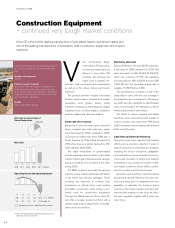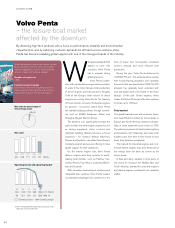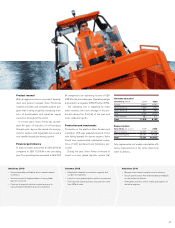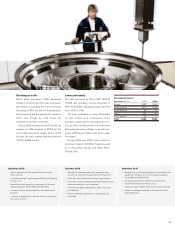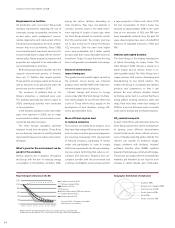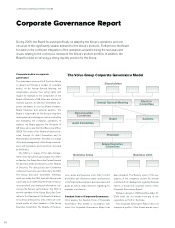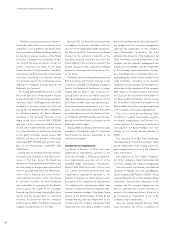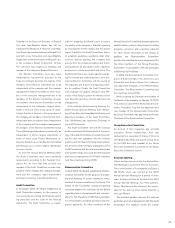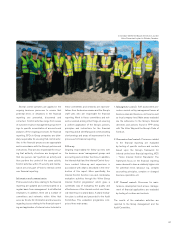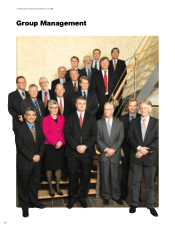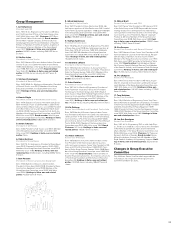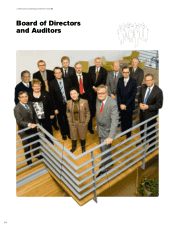Volvo 2009 Annual Report Download - page 58
Download and view the complete annual report
Please find page 58 of the 2009 Volvo annual report below. You can navigate through the pages in the report by either clicking on the pages listed below, or by using the keyword search tool below to find specific information within the annual report.
BOARD OF DIRECTORS’ REPORT 2009
2000
0
20
60
40
80
120
100
Within the EU all road transport emissions except for CO2 are expected
to decrease in the future. This is the result of stringent emission regulations.
1995 2005
Particulate matter (PM) from diesels
Sulphur dioxide SO2
Solvents (VOCs)
Carbon dioxide (CO2 )
Carbon monoxide (CO)
Nitrogen oxides (NOX)
Benzene
2010 2015 2020
Source: ACEA – European Automobile
Manufaturers' Association.
Road transport emissions in the EU Geographic distribution of employees
Sweden 25%
Europe, excl. Sweden 33%
North America 14%
South America 5%
Asia 20%
Other countries 3%
Requirements on facilities
All production units must meet Group-wide
minimum requirements regarding the use of
chemicals, energy consumption, emissions to
air and water, waste management, environ-
mental organization and improvement efforts.
If local laws and regulations are more compre-
hensive they must be followed. Since 1989,
environmental audits have been carried out to
ensure that all plants comply with the environ-
mental policy. Newly acquired companies and
properties are subjected to an examination of
environmental factors and risks.
All the Group’s production facilities have the
requisite environmental permits. In Sweden,
there are 17 facilities that require permits.
These permits encompass waste and noise as
well as emissions to air, ground and water. No
permits are due for renewal in 2010.
The existence of polluted land on the
Group’s properties is cataloged every year.
This pollution generally has historic origins. In
2009, cleaning-up activities were conducted
on two properties.
In the Swedish operations a few minor leak-
ages were reported in 2009, but no major
environmental incidents occurred and no envi-
ronmental disputes took place.
The Volvo Group’s operations generate
transport to and from the plants. These flows
are continuously reviewed to identify potential
improvement measures to reduce environmen-
tal impact.
What’s good for the environment can be
good for the economy
Various projects are in progress throughout
the Group with the aim of reducing energy
consumption in the facilities. Activities differ
among the various facilities, depending on
local conditions. They have one element in
common, however, which is the initial invest-
ment required. A couple of years ago, when
the Volvo Group decided to create the world’s
rst CO2-neutral plant, the primary goal was
not to save money but to reduce the Group’s
CO2 emissions. Over the short term higher
costs were anticipated, but it rather quickly
became clear that it was a favorable economic
investment. Today, it is clear that over the long
term, it will generate considerable cost savings.
Greatest environmental
impact during use
The greatest environmental impact caused by
the products occurs during use. Lifecycle
analyses show that 80–90% of the total envi-
ronmental impact arises during use.
Climate change and access to energy
sources may affect the Volvo Group. It is there-
fore vital to prepare for use of fuels other than
crude oil. These efforts focus largely on the
development of new drivelines, energy ef-
ciency and alternative fuels.
More efficient engines lead
to reduced emissions
The products use mainly diesel engines, since
they have high energy efciency and low emis-
sions. In many countries, government agencies
are imposing increasingly strict requirements
of reduced emissions, particularly of nitrous
oxides and particulates. In order to comply
with these requirements, the Group is develop-
ing new engine technology that reduces con-
sumption and emissions. Reduced fuel con-
sumption benets both the environment and
customers’ protability, since fuel accounts for
a large proportion of their costs. Since 1975,
the fuel consumption of Volvo’s trucks has
declined by approximately 40% at the same
time as the emissions of NOx and PM have
been dramatically reduced. Over the past 30
years, diesel engines have seen a hundredfold
reduction of regulated emissions of NOx and
PM.
Vehicles with hybrid driveline
The Volvo Group is the leading manufacturer
of hybrid technology for heavy trucks. The
Volvo Group’s I-SAM concept is based on a
diesel engine and an electric motor, a so-
called parallel hybrid. The Volvo Group has a
unique process that involves developing and
manufacturing its own hybrid solution. This
enables the Group to coordinate and optimize
products and components so that it can
achieve the most efcient driveline. Hybrid
technology works best in a vehicle that has a
driving pattern involving numerous starts and
stops. Field tests have shown fuel savings of
30% for a city bus. Extensive work is currently
under way to develop and test hybrid solutions.
CO2-neutral transports
As part of the efforts with alternative fuels, the
Volvo Group was the rst vehicle manufacturer
to develop seven different demonstration
trucks that all can be driven without net emis-
sions of climate-impacting carbon dioxide. The
vehicles can operate on biodiesel, biogas,
biogas combined with biodiesel, ethanol/
methanol, dimethyl ether (DME), synthetic
diesel and hydrogen gas combined with biogas.
These fuels are produced from renewable raw
materials and therefore do not result in a net
increase in carbon dioxide upon combustion.
54


